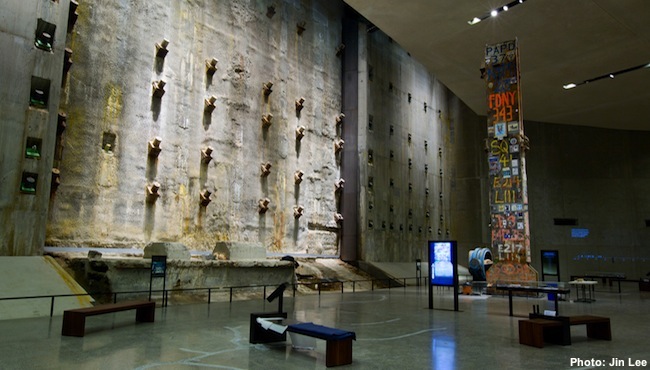The National September 11 Memorial and Museum yesterday recognized the completion of the 9/11 Memorial Museum, upholding a commitment to honor the heroes, remember the victims, and preserve the history of the 9/11 attacks, their precursors, and aftermath for generations to come.
A tribute-filled, days-long Dedication Period, which includes a ceremony and Museum previews, begins today and lasts through May 20 for 9/11 families, 9/11 rescue and recovery workers, active duty first responders, survivors, and lower Manhattan residents and business owners.
Keeping the Museum's doors open for 24 hours during this period will also serve as a small tribute to the thousands of Ground Zero rescue and recovery workers who worked around the clock in the aftermath of 9/11 as the city, the nation and the world supported them. The Museum then opens to the public on May 21.
“The opening of the 9/11 Museum is an important milestone for our city and our country,” said Michael R. Bloomberg, Chairman of the 9/11 Memorial & Museum, Philanthropist and Mayor of New York City from 2002-2013. “The Museum tells heartbreaking stories of unimaginable loss, but also inspiring stories of courage and compassion."
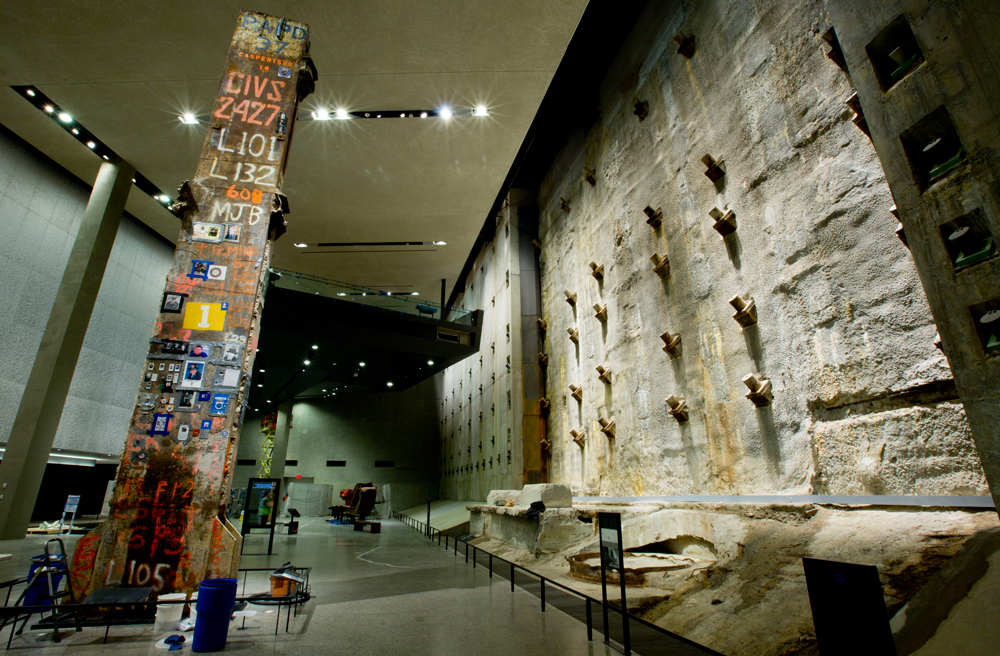
As the recovery at the World Trade Center site neared completion, the Last Column, a 58-ton, 36-foot-tall piece of welded plate steel, was removed from the site in a solemn ceremony on May 30, 2002. In the weeks that followed, recovery workers, first responders, volunteers and victims’ relatives signed the column and affixed to it memorial messages, photographs, and other tributes. Photo: Jin Lee / Courtesy 9/11 Memorial Museum
Davis Brody Bond is the lead architect on the Museum below the Memorial plaza. The Museum’s entry pavilion was designed by Snøhetta. The museum’s 110,000 square feet of exhibition space tells the story of 9/11 through multimedia displays, personal narratives and a collection of monumental and personal artifacts.
The space includes two core exhibitions at the archeological heart of the site: the memorial exhibition, called “In Memoriam,” and a three-part historical exhibition that explores the day of the attacks, what led to them and their aftermath. The exhibition designers include Thinc, Local Projects, and Layman Design.
“The magnitude of the historic importance of the site and its symbolism made it essential for us to find a balance between the collective and the individual experience,” said Steven M. Davis, FAIA, founding partner of Davis Brody Bond. “We relied on four principles to guide our work: memory, authenticity, scale and emotion, hoping to provide the most sensitive, respectful and informative experience for visitors.”
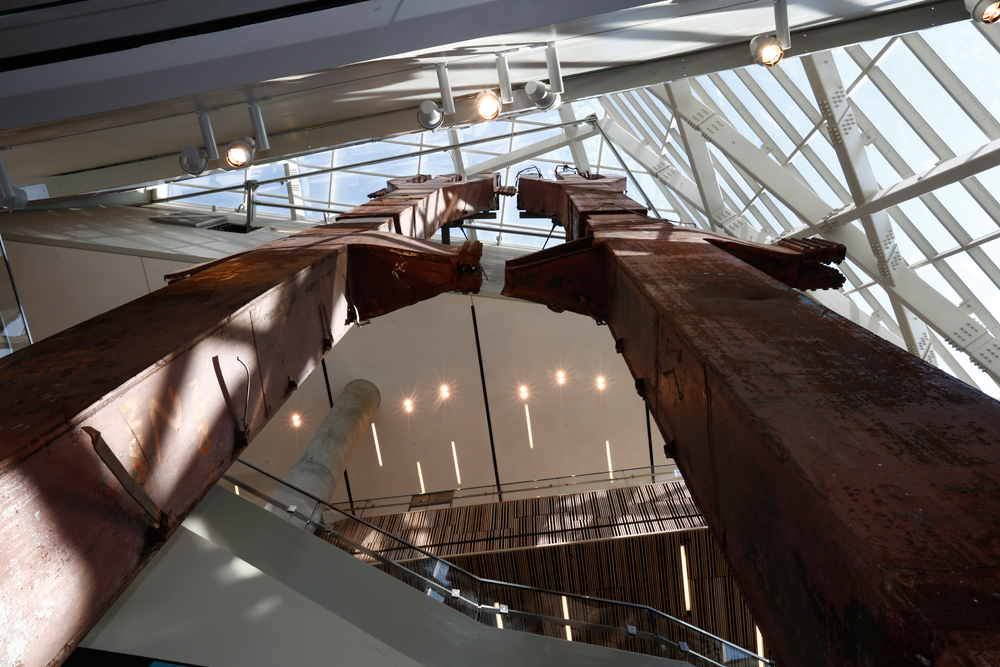
Recovered from the World Trade Center Site after September 11, 2001, these steel “tridents” once formed part of the exterior structural support of the east façade of 1 World Trade Center (North Tower). Welded to box columns at bedrock, 70 feet below street level, these branched from one column into three prongs at the fifth story. They are located in the Museum’s entry pavilion. Photo: Jin Lee / Courtesy 9/11 Memorial Museum
Davis Brody Bond's design essay on the 9/11 Memorial Museum
The 9/11 Memorial Museum was conceived as the global focal point for presenting and preserving the history and memories of the events of 9/11, documenting the impact of the attacks and exploring their enduring significance. The Museum is located beneath the 9/11 Memorial at the World Trade Center.
Descending nearly 70 feet to the original footprint of the World Trade Center towers, its 110,000 square-foot interior will give visitors access to the monumental underground site where remnants of the Trade Center’s construction and recovery frame the story of the terrorist attacks and the days that followed.
Confronting the physical void left at the end of the recovery process, the spaces of the museum are revealed, progressively disclosing the various elements of collective and personal memory of the event.
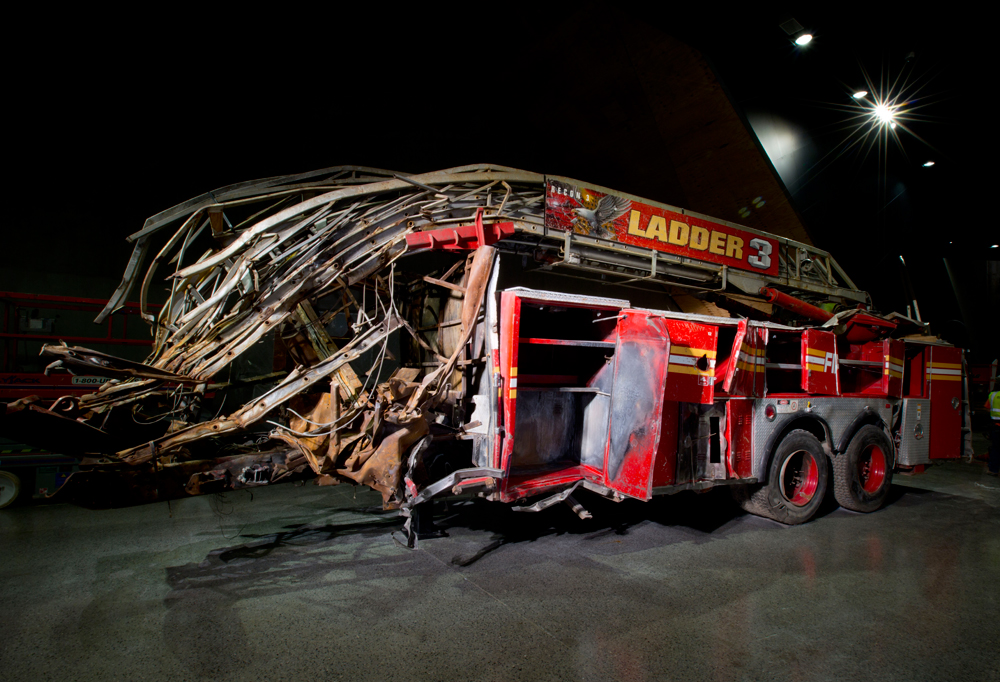
Assigned to aid in the evacuation of civilians in the North Tower on 9/11, members of FDNY Ladder Company 3 are known to have reached the 35th floor by 9:21 a.m. All 11 responding members of Ladder Company 3 were killed inside the North Tower when it collapsed at 10:28 a.m. The front cab of this fire truck was shorn off when the North Tower collapsed. The bumper and a door were later removed and displayed as a memorial in Ladder Company 3’s quarters on East 13th Street in Manhattan. The inscription “JEFF WE WILL NOT FORGET YOU!” was painted by a firefighter related to Jeffrey John Giordano, a Ladder Company 3 member who was killed on 9/11. Photo: Jin Lee / Courtesy 9/11 Memorial Museum
Given a fixed set of existing geometries at the site, we were faced with the challenge of translating them into a series of coherent spaces that are punctuated by surface, texture and volume. We chose as the space’s main narrative element a gently descending procession (dubbed “the Ribbon”) that guides visitors from the plaza to the bedrock level where the cut columns of the World Trade Center towers are revealed.
The “ribbon” evokes the ramp used to remove debris from the site in the aftermath of the attacks. It also offers multiple views of the slurry wall, the original retaining wall that was built to withstand the lateral forces of landfill and river, and which survived the collapse of the towers.
At the end of the ribbon, the descent continues down along the Vesey Street Stair (“Survivors’ Stairs”), which were used by hundreds to escape to safety on 9/11. It ultimately leads to two exhibition spaces and Foundation Hall, the Museum’s culminating space whose sheer scale conveys a sense of the enormity of the site and reinforces awareness of the absence of what once was there.
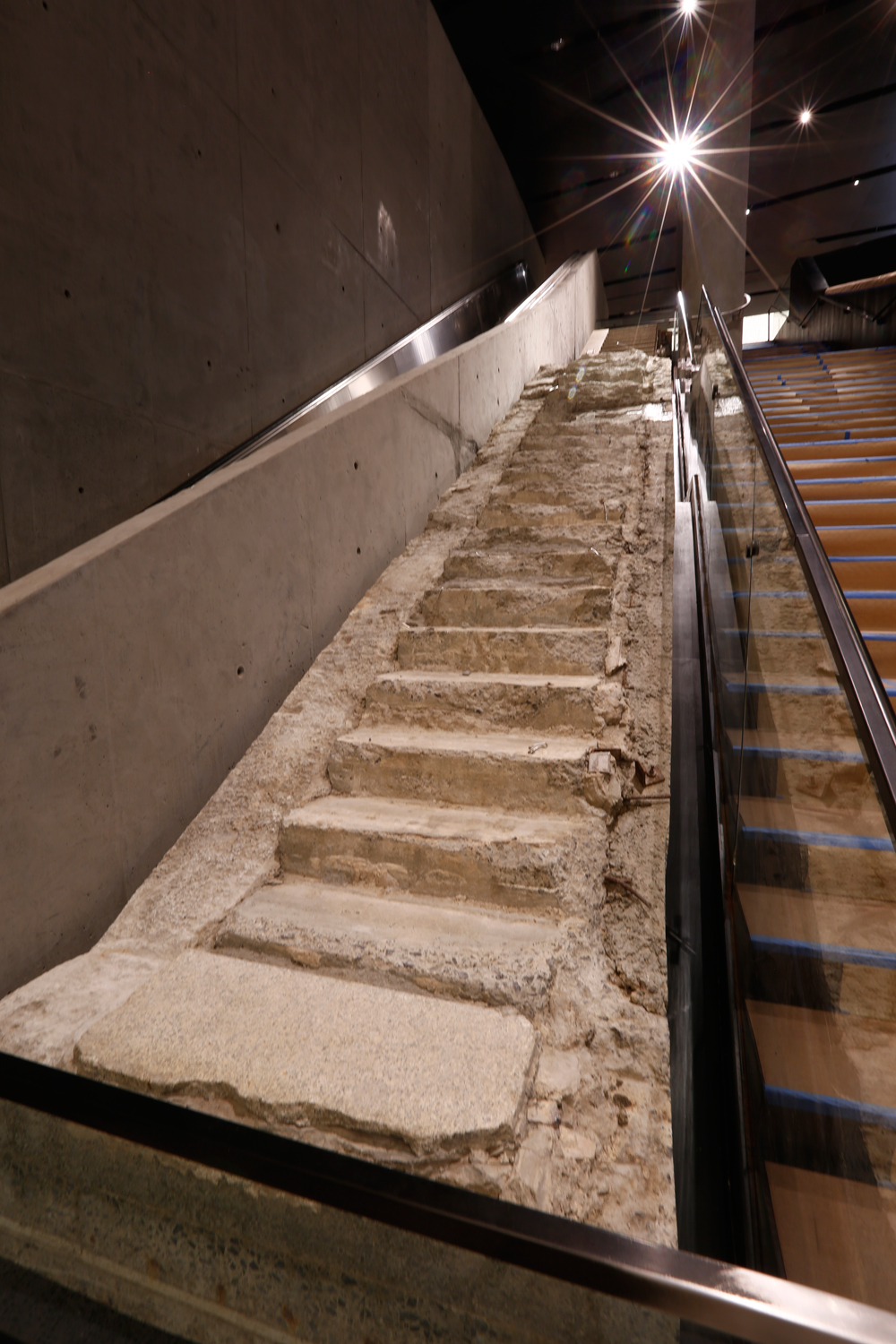
The Vesey Street stairs, or Survivors’ Stairs, once connected the northern edge of the World Trade Center Plaza to the Vesey Street sidewalk below. On September 11, 2001, the stairs and an adjacent escalator provided an unobstructed exit for hundreds seeking to escape. Photo: Jin Lee / Courtesy 9/11 Memorial Museum
The Building Team also included:
- Lend Lease – Construction Manager
- WSP - Structural Engineering
- Guy Nordenson and Associates - Structural Engineering: Slurry Wall
- Simpson Gumpertz & Heger, Inc. - Structural Engineering: Slurry Wall
- Weidlinger Associates Consulting Engineers - Blast Design
- Jaros Baum & Bolles - MEP Engineering/Vertical Transportation
- Fisher Marantz Stone - Lighting Designer
- Langan Engineering & Environmental Services - Geotechnical Engineering
- Mueser Rutledge Consulting Engineers - Geotechnical Engineers: Slurry Wall
- Code Consultants Inc. - Code Consulting
- Cerami & Associates, Inc. - Acoustical and Vibration Design
- C&G Partners - Graphics
- Higgins & Quasebarth - Historic Preservation
- ARUP - Security Design
- Viridian Energy & Environmental, LLC - Sustainability Consultant
- Wiss Janey Elstner, Associates - Building Envelope and Waterproofing
- Construction Specifications, Inc. - Specifications
- Faithful + Gould - Cost Estimating
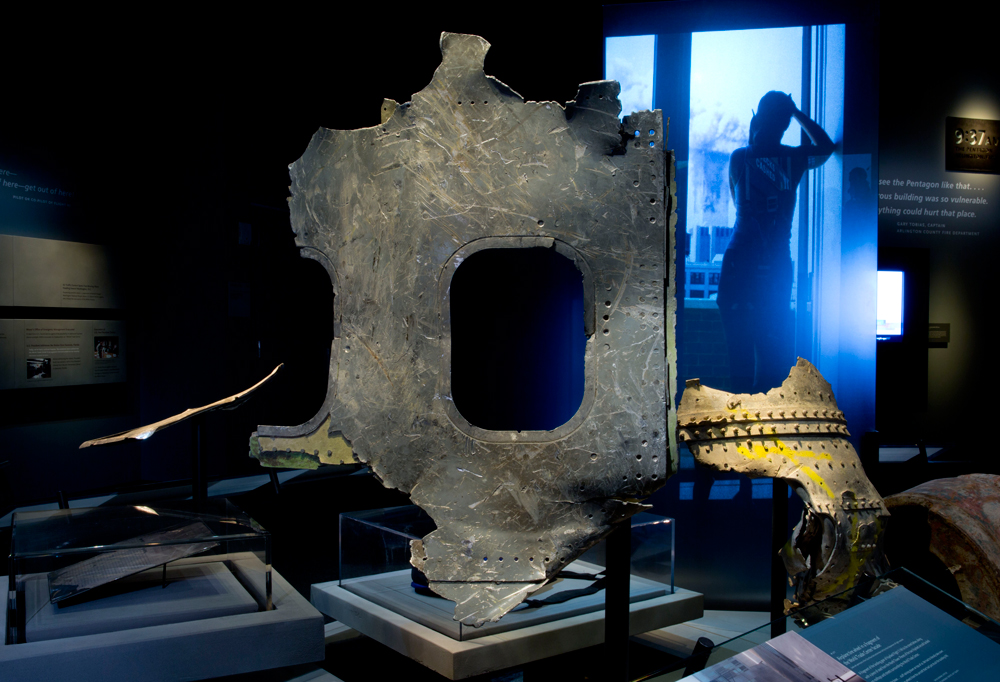
Photo: Jin Lee / Courtesy 9/11 Memorial Museum
Lend Lease's statement on the project
Lend Lease is proud to have served as the construction manager for the National September 11 Memorial and Museum. The Memorial part of the structure was opened on September 11, 2011 in commemoration of the 10th anniversary of the terrorist attacks of September 11, 2001.
The Museum occupies approximately 180,000 gross sf of space spread over three below-grade levels. These levels include lobby, security, visitor services, assembly, administrative, exhibition, education, support service and loading bay spaces. The Museum and Entry Pavilion are located on the western edge side of the Memorial quadrant. Below grade, the Memorial Museum is bound by the Memorial plaza overhead, the Memorial pools, shared support spaces, the central chiller plant, the Port Authority Trans-Hudson (PATH) tracks and terminal and the slurry wall.
Visitors will enter the Museum through the Entry Pavilion which houses an auditorium, a private room for victims’ families and support functions such as information, bathrooms, way–finding, security and elevators. The Museum’s “Memorial Hall,” contains exhibition space located at the first level of the original World Trade Center (WTC) below grade.
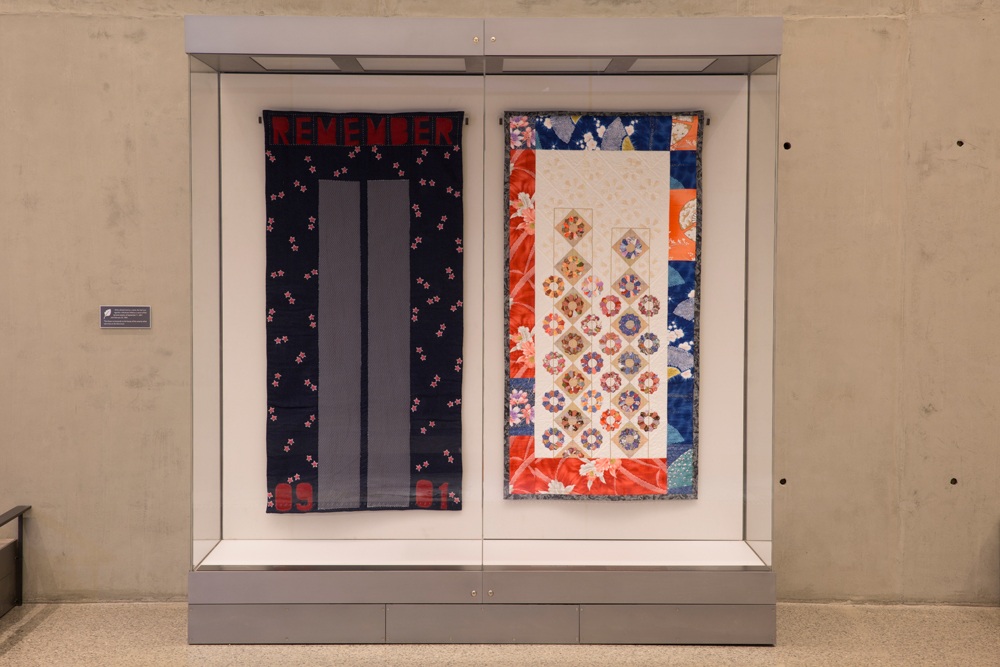
Photo: Jin Lee / Courtesy 9/11 Memorial Museum
The lowest level at bedrock features the original west slurry wall which is supported by a counter fort system and the remaining west slurry wall with a concrete reinforced liner. The original tower footprints are defined by the preserved original box column remnants which are visible and accessible to visitors.
The National September 11th Museum is targeting a LEED-NC Gold rating upon project completion. To reduce the impact on the local environment, stay in compliance with the World Trade Center Sustainable Design Guidelines, and Lower Manhattan Environmental Performance Commitments. All diesel-powered construction equipment on the project was retrofitted with diesel particulate filters and used ultra-low sulfur diesel, and all impact equipment was fitted with mufflers or noise blankets. Furthermore, concrete wash-off water was treated before it was discharged to the storm sewer, protecting neighboring water bodies from possible adverse effects from lime.
To reduce resource use and waste to landfill, the project achieved 75% diversion of construction and demolition waste from land fill. To accomplish this goal waste was sorted on site into individual recyclable material categories. This project filtered, dewatered and pumped surface water on site for construction purposes, such as fugitive dust control and wheel washing. To conserve water during operation, the pavilion has a storm water collection and treatment system that allows water to be reused for irrigation.
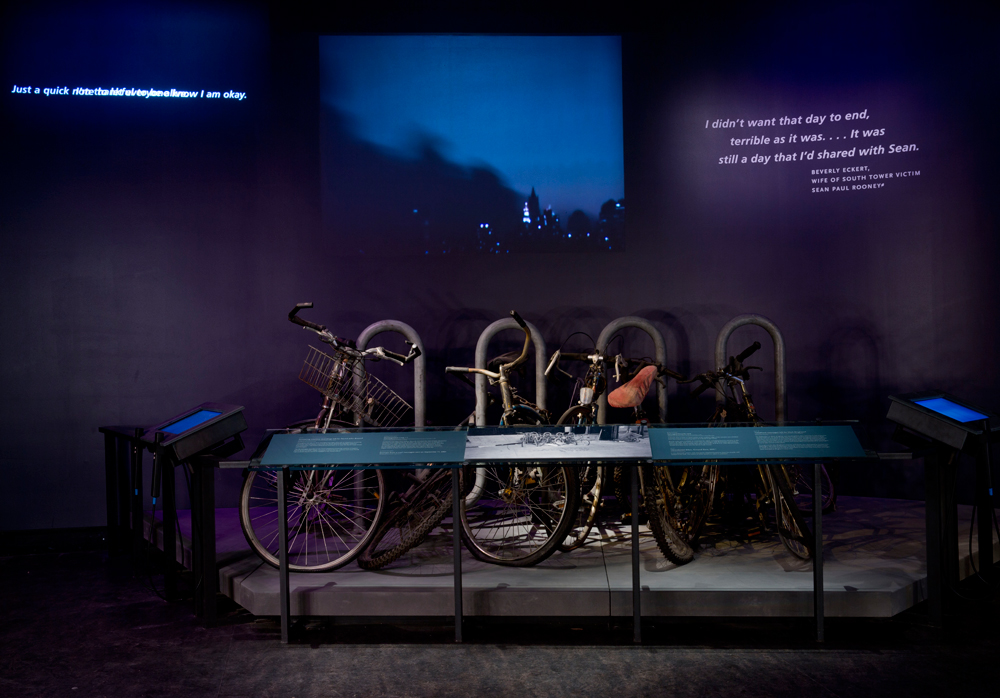
Photo: Jin Lee / Courtesy 9/11 Memorial Museum
To optimize the quality of the indoor environment, Lend Lease developed and implemented a Construction IAQ Management Plan that protected the HVAC system from dust during construction, protected materials from moisture damage.
The pavilion has a light-colored, highly reflective roof to preclude the “heat island effect” (hot spot) black roofs create. To reduce operating costs and carbon emissions premium efficiency chillers/equipment and occupancy sensor controlled lighting were used. Further, the client hired a third-party Commissioning Authority to validate the performance of the mechanical, lighting and domestic water systems.
Since September 11, 2011, Lend Lease has had the honor of working on the WTC site. Lend Lease and three other contractors were assigned by the City of New York to conduct recovery efforts. As the recovery effort moved into the next phase, Lend Lease was designated the lead contractor overseeing the entire cleanup operation. For 265 days Lend Lease staff lead, coordinated, and worked with the New York Police and New York City Fire Department’s personnel and thousands of volunteers to complete the recovery operation. Over 1.6 million tons of debris was removed from the site during the recovery phase over.
For more on the 9/11 Memorial and Museum, visit 911memorial.org.
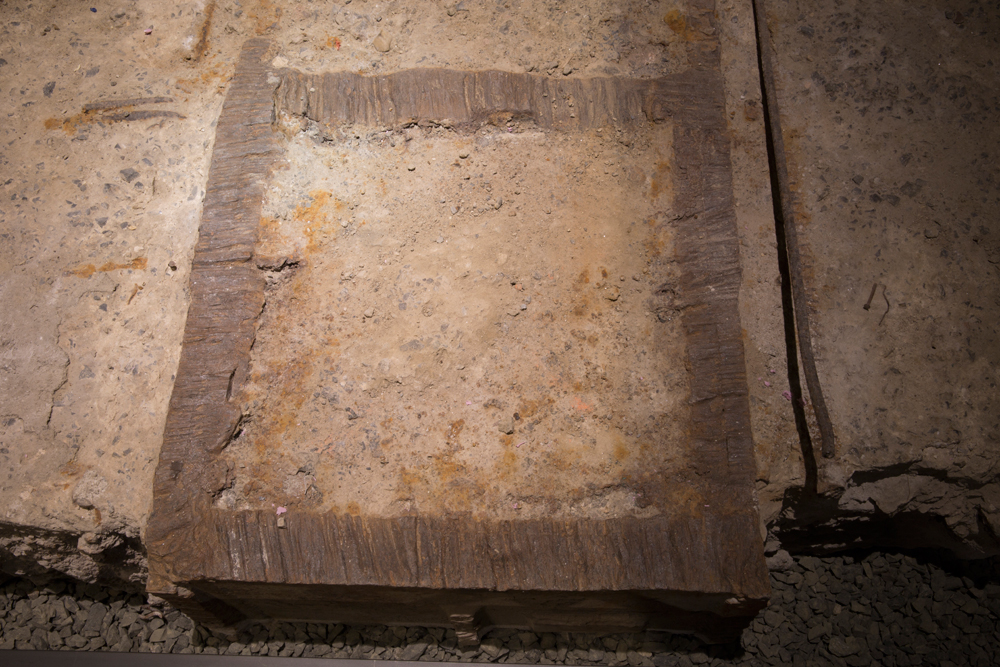
Photo: Jin Lee / Courtesy 9/11 Memorial Museum
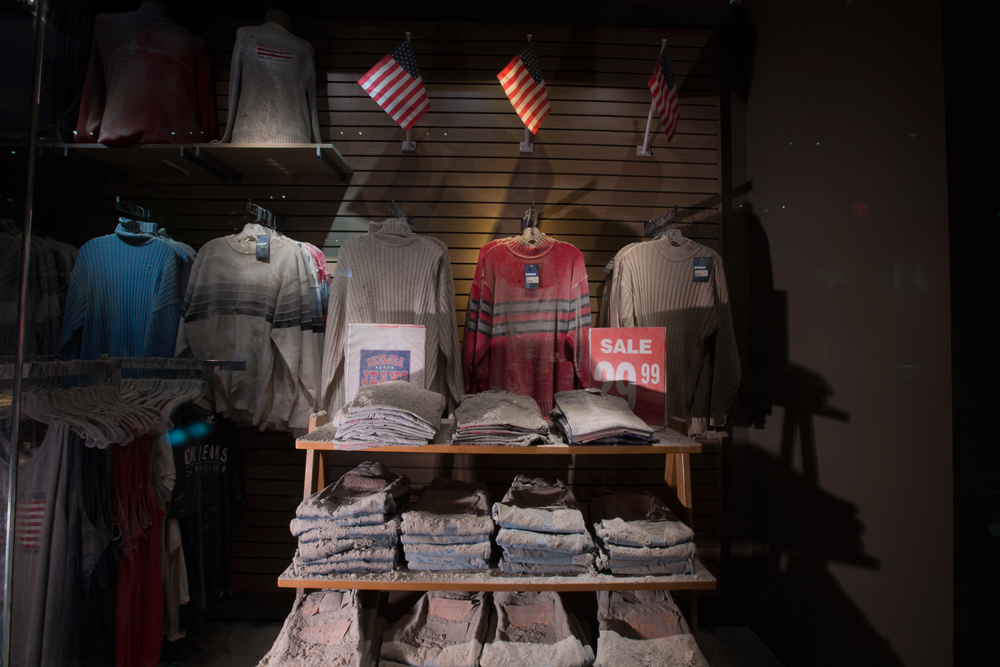
Photo: Jin Lee / Courtesy 9/11 Memorial Museum
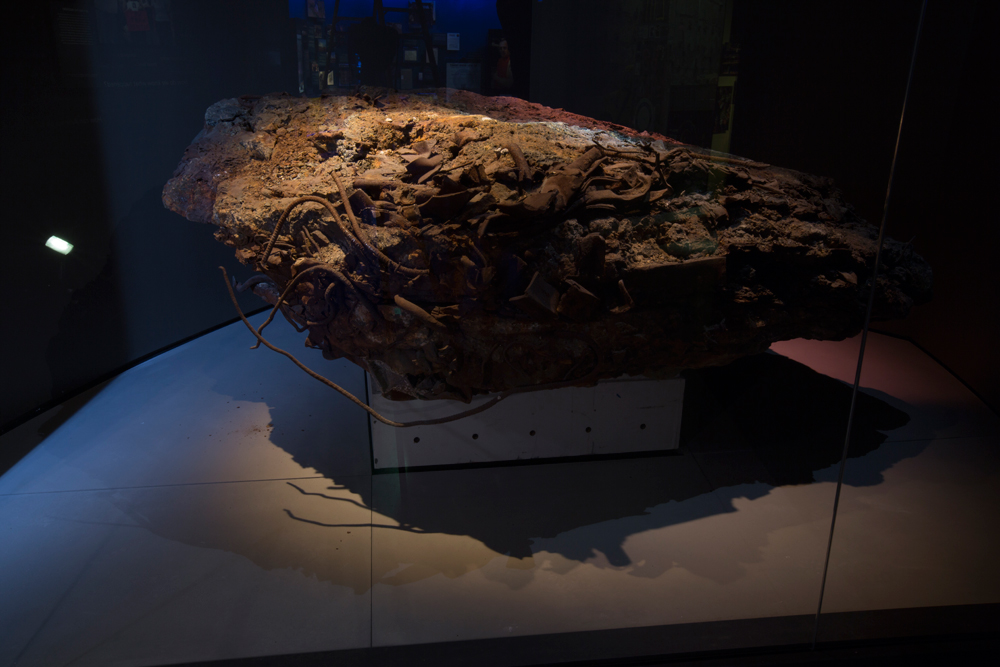
Photo: Jin Lee / Courtesy 9/11 Memorial Museum

When hijacked Flight 11 struck the North Tower, it severed elevator cables and trapped hundreds of people above floor 93. Below the impact zone, most on floors lower than 92 were able to evacuate via the stairs. This elevator motor, the largest model in the world when installed, powered one of the express or service cars, which moved at a speed of 1,600 feet per minute. Photo: Jin Lee / Courtesy 9/11 Memorial Museum
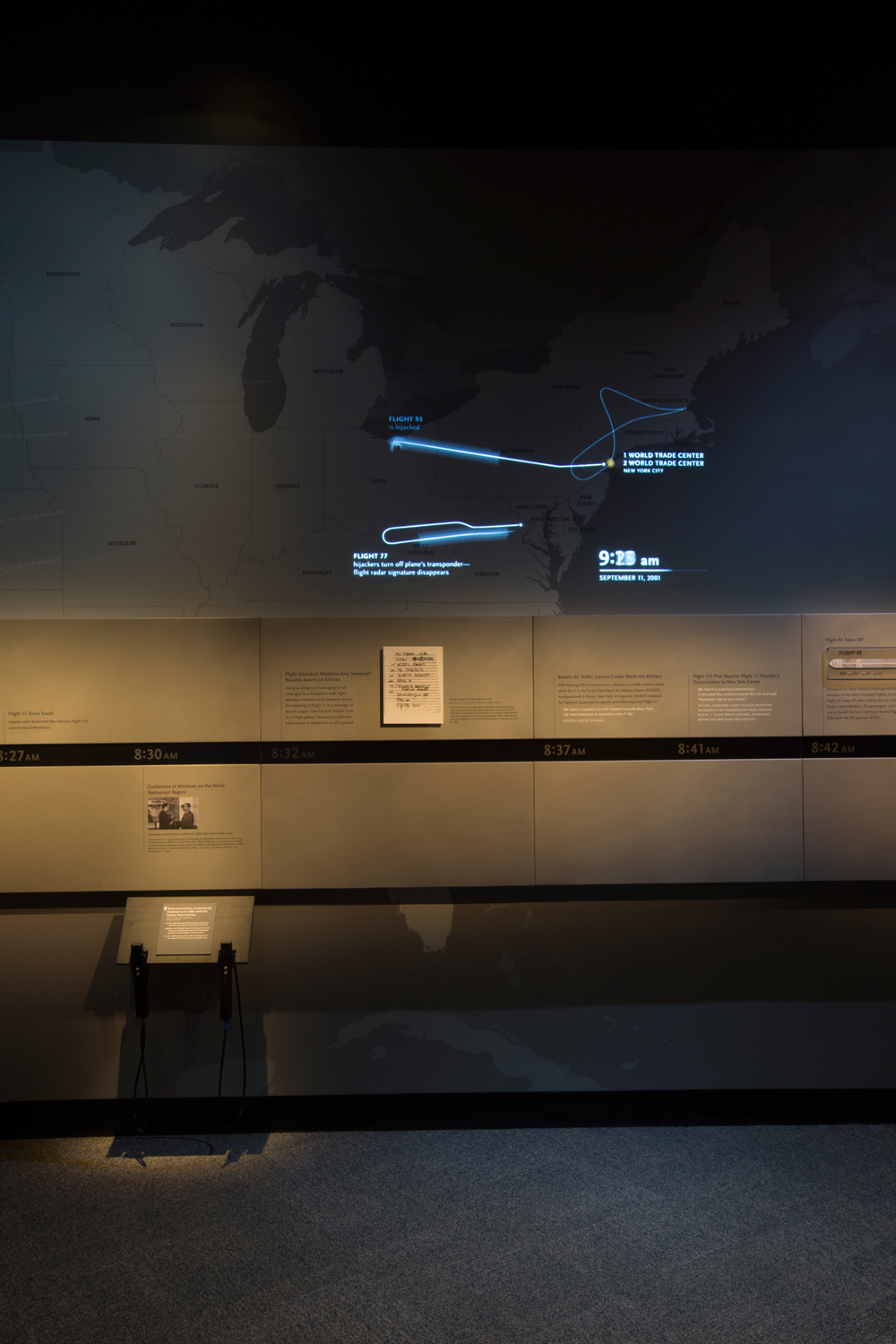
Photo: Jin Lee / Courtesy 9/11 Memorial Museum
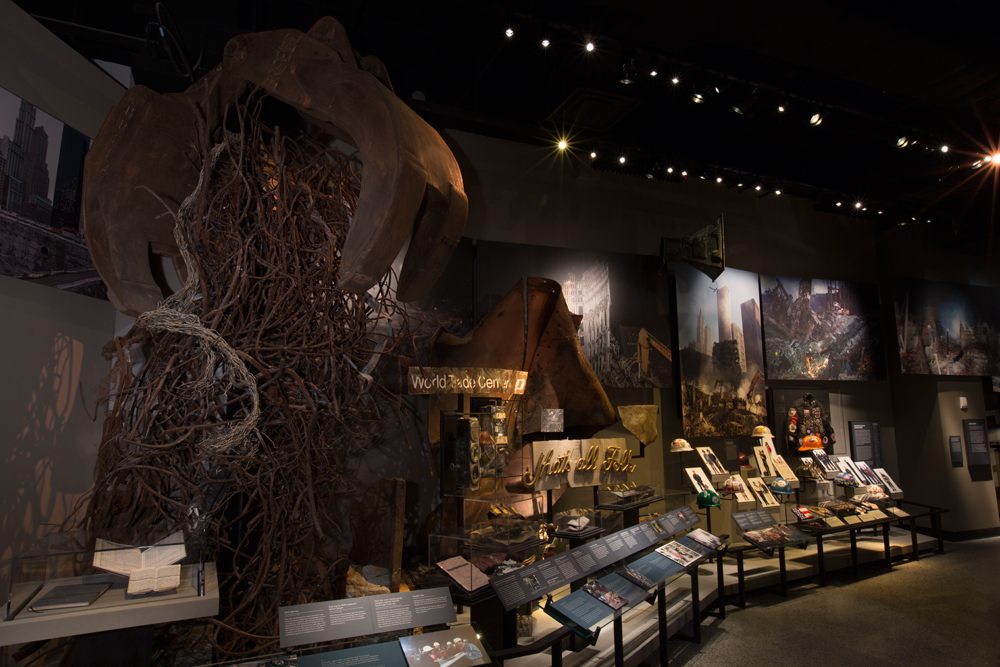
Photo: Jin Lee / Courtesy 9/11 Memorial Museum
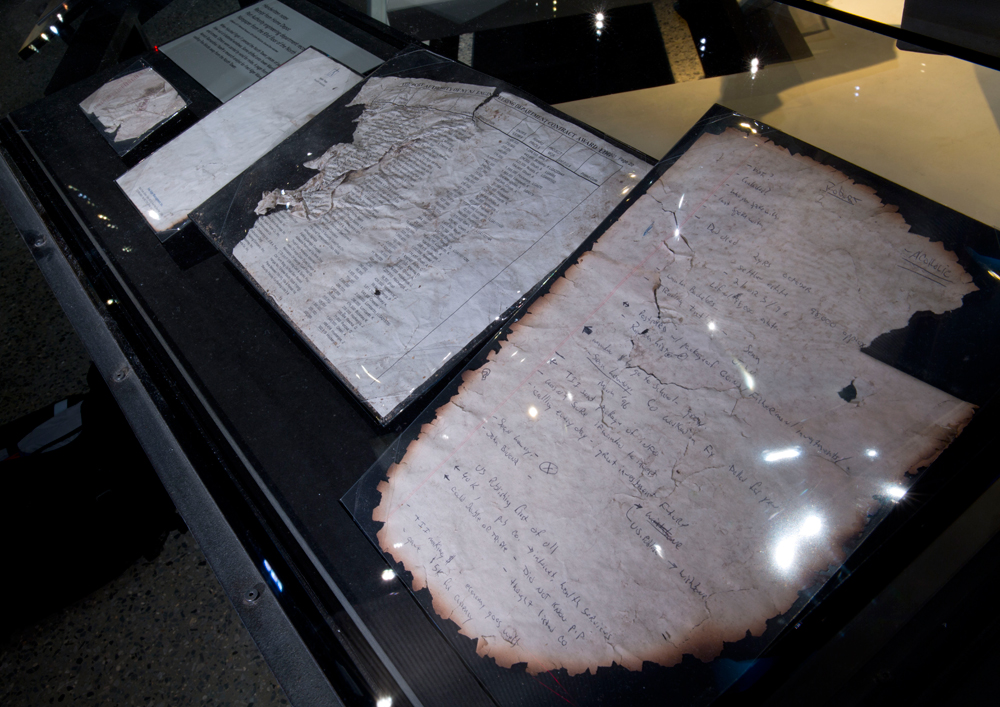
Photo: Jin Lee / Courtesy 9/11 Memorial Museum
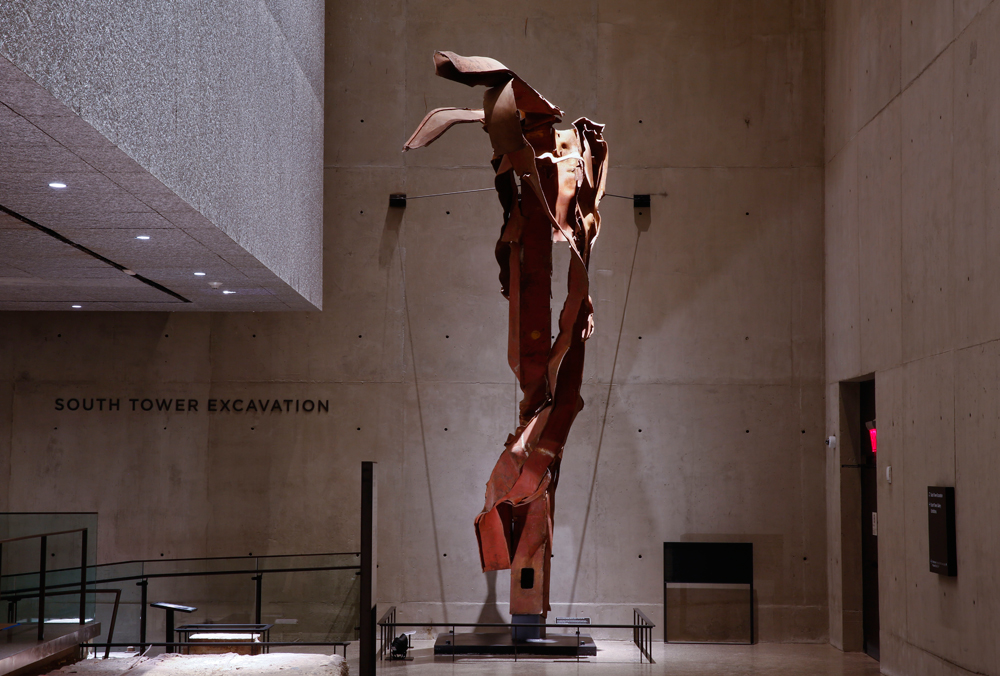
This piece of steel, once part of the façade of the North Tower, was located at the point of impact where hijacked Flight 11 pierced the building from floors 93 through 99. A companion piece of façade steel from floors 93 through 96 is displayed in the South Tower Excavation. Photo: Jin Lee / Courtesy 9/11 Memorial Museum
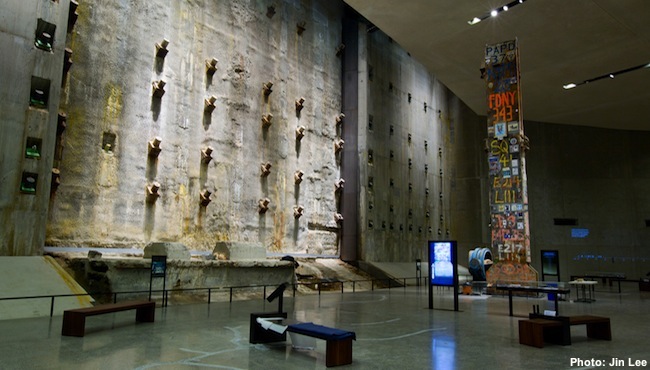
Photo: Jin Lee / Courtesy 9/11 Memorial Museum
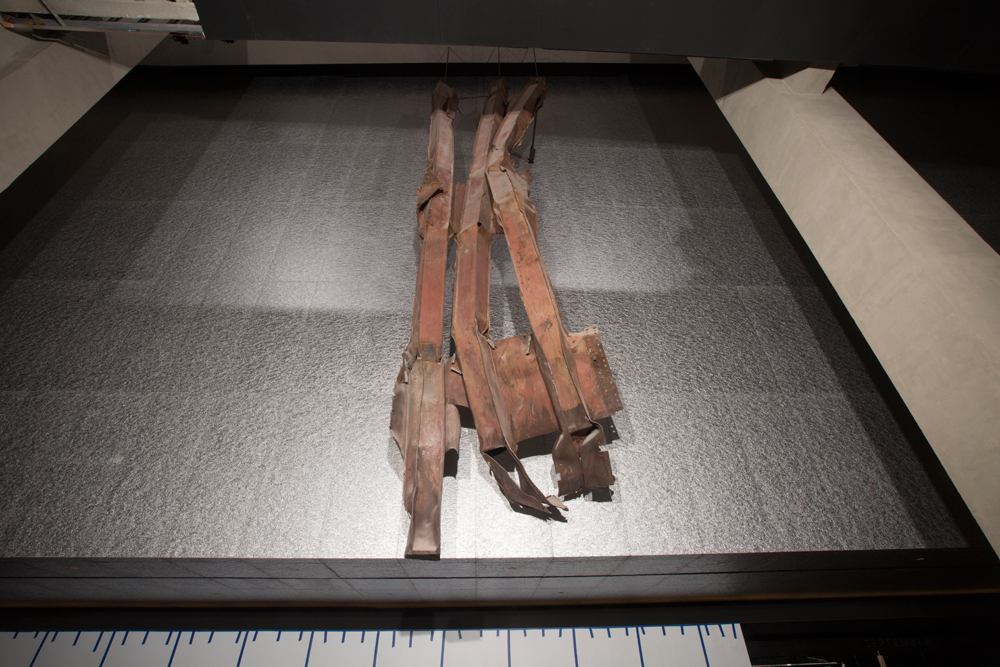
Photo: Jin Lee / Courtesy 9/11 Memorial Museum
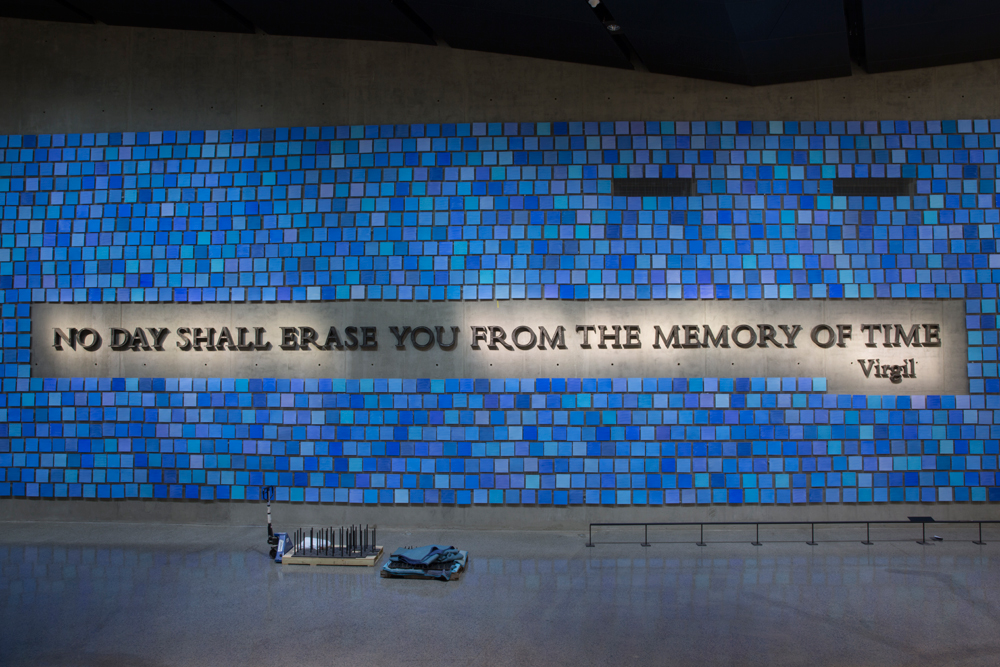
The letters of the quotation from Virgil’s “Aeneid” were forged out of remnant World Trade Center steel by New Mexico blacksmith Tom Joyce (American, b. 1956). Photo: Jin Lee / Courtesy 9/11 Memorial Museum
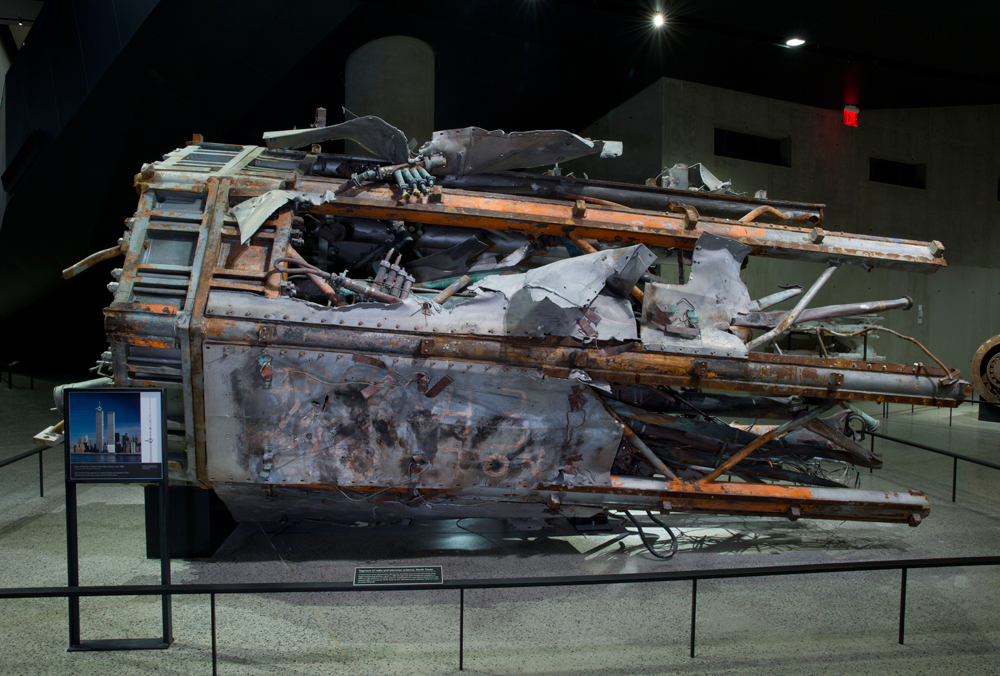
This 19.8-foot-long fragment was about one-twentieth of the 360-foot-tall transmission tower atop the North Tower. Six broadcast engineers affiliated with five television stations were working from offices on floors 104 and 110 of the North Tower on 9/11. None of the engineers survived. Transmissions for most stations failed shortly after hijacked Flight 11 pierced the North Tower. All transmissions ceased by 10:28 a.m., when the tower collapsed. Photo: Jin Lee / Courtesy 9/11 Memorial Museum
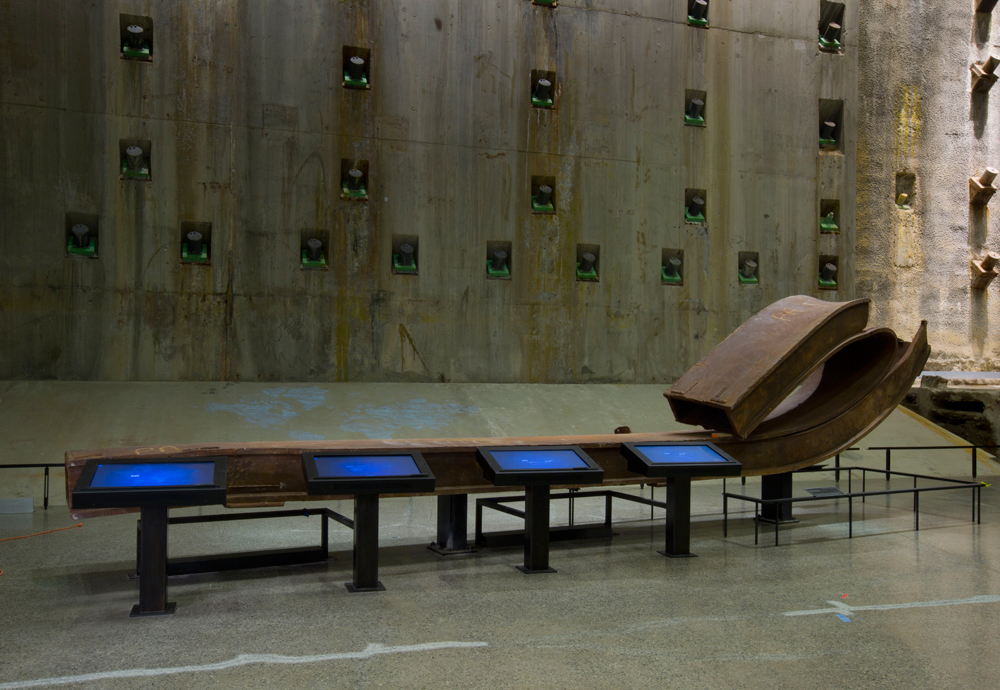
Photo: Jin Lee / Courtesy 9/11 Memorial Museum
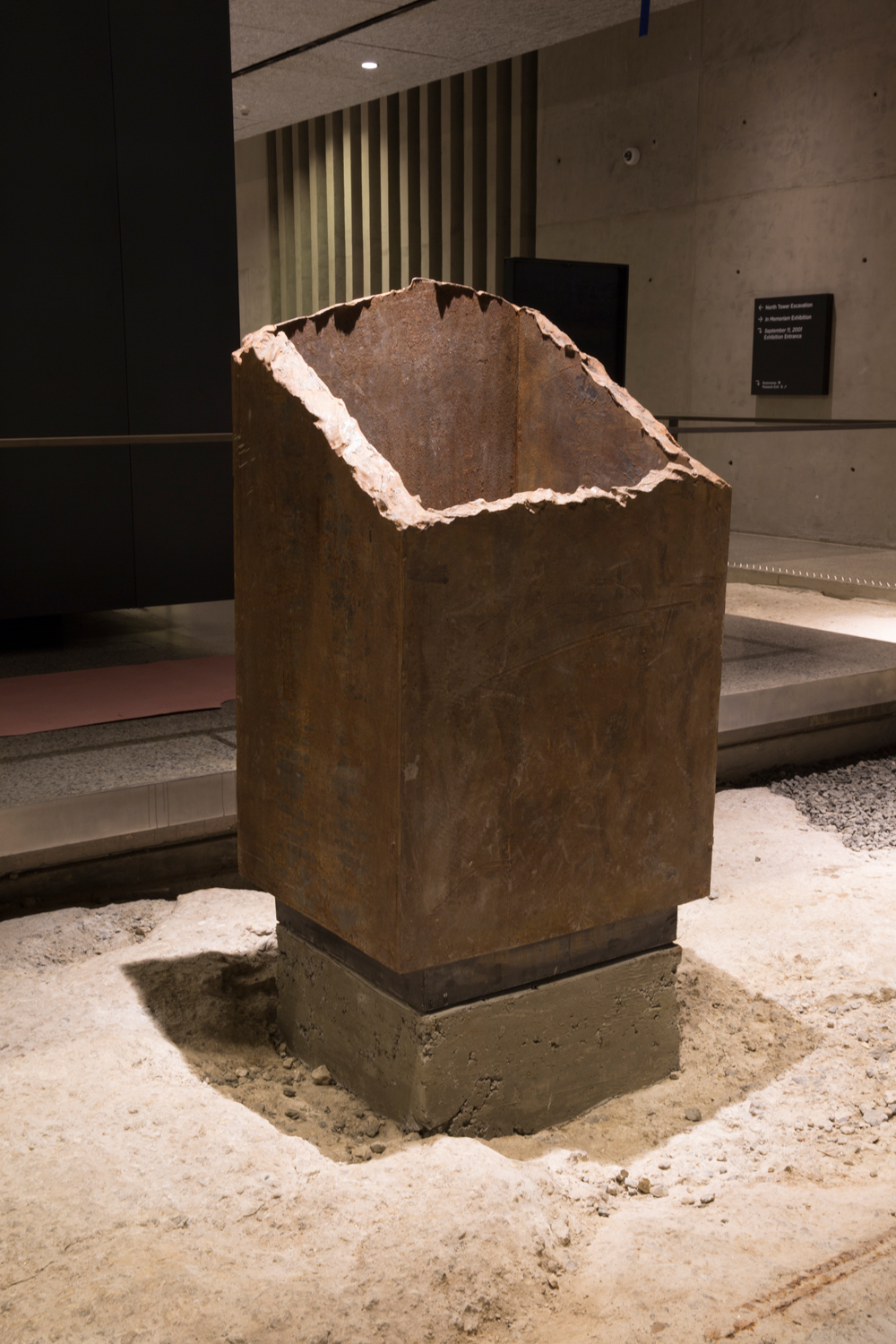
Standing box column. Photo: Jin Lee / Courtesy 9/11 Memorial Museum
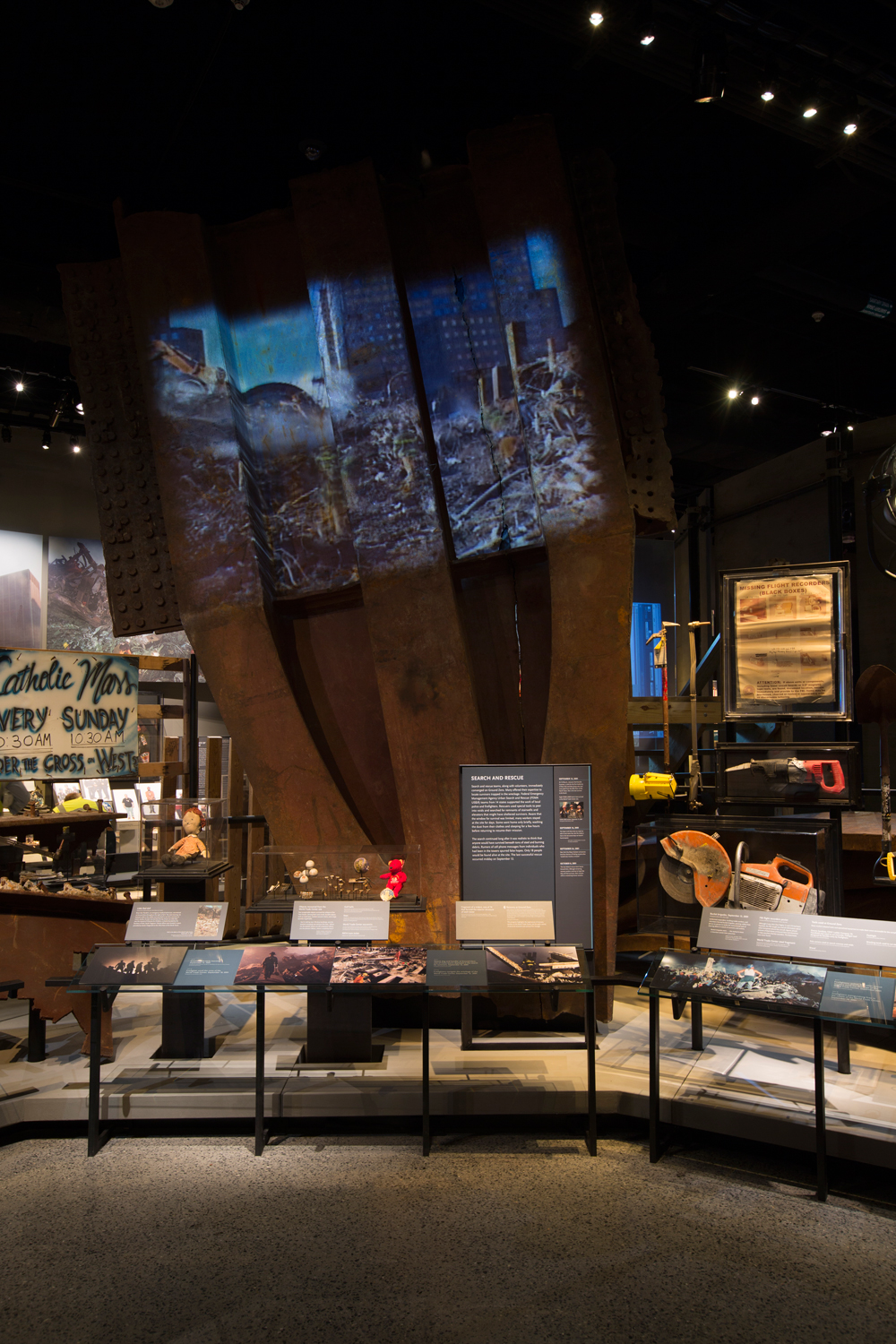
Steel trident. Photo: Jin Lee / Courtesy 9/11 Memorial Museum
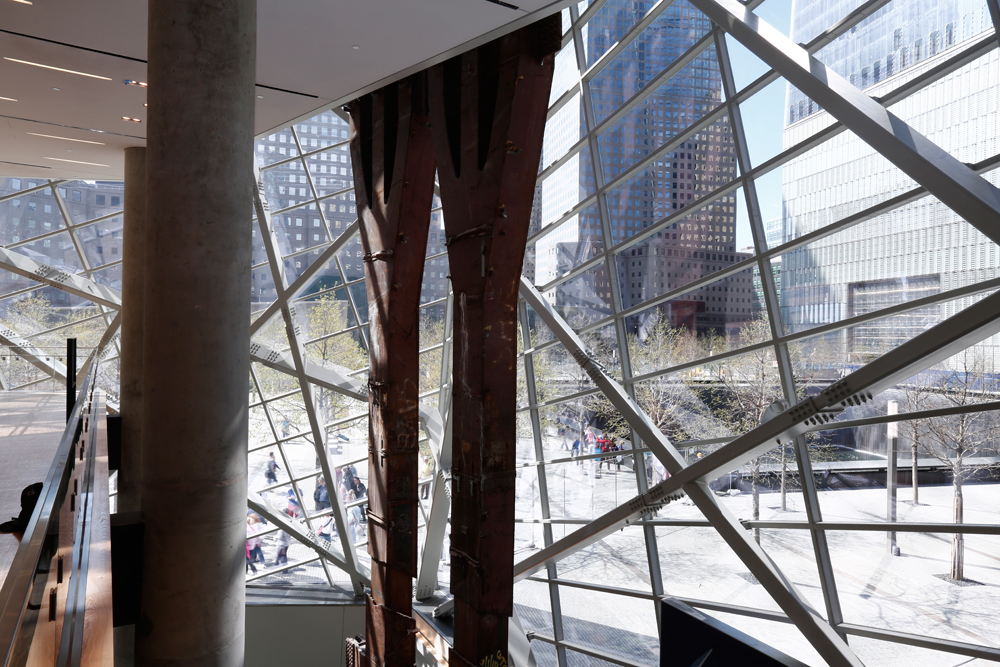
Photo: Jin Lee / Courtesy 9/11 Memorial Museum
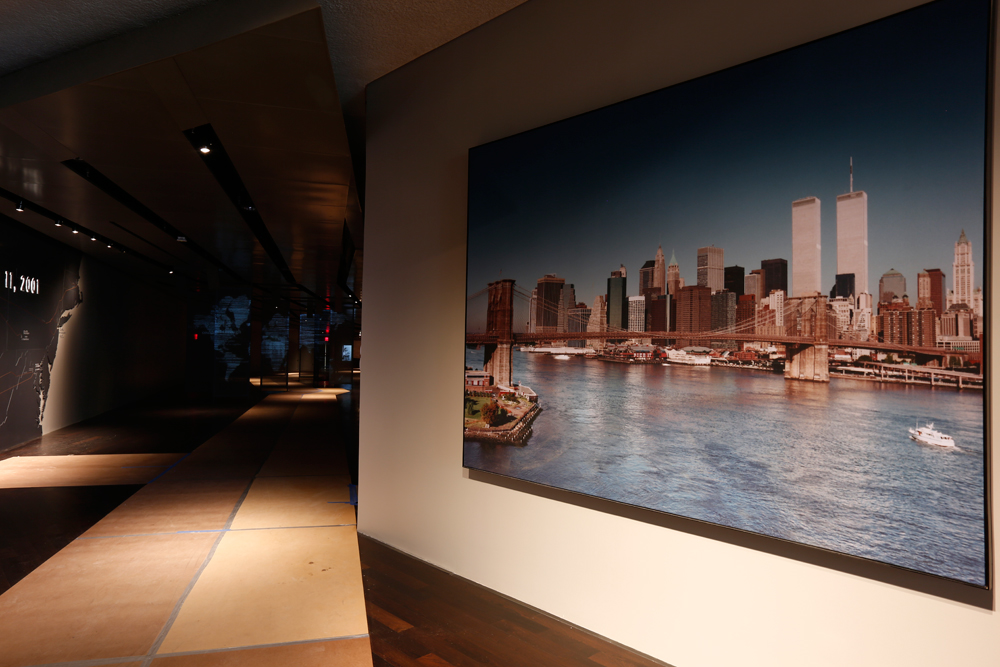
Photo: Jin Lee / Courtesy 9/11 Memorial Museum
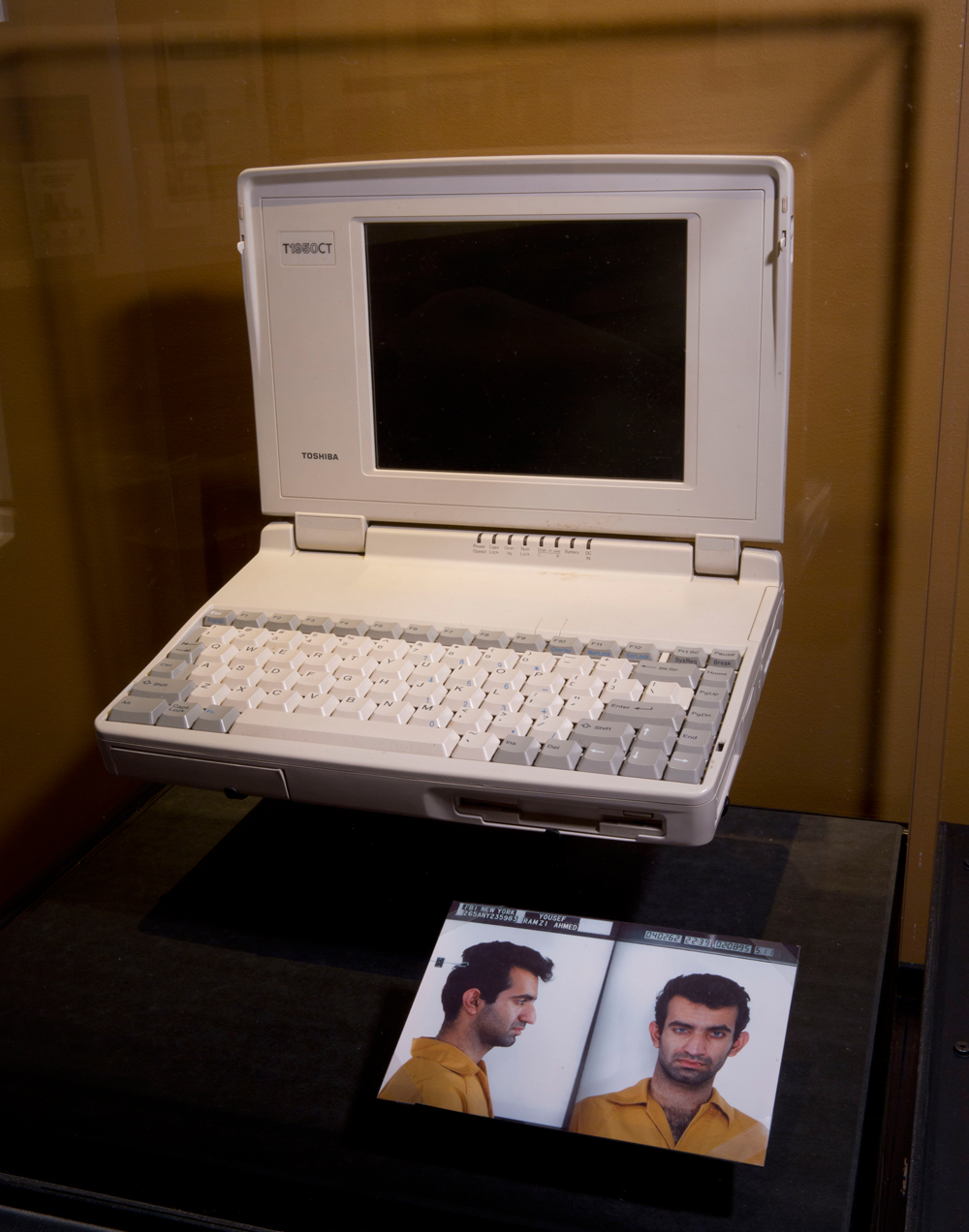
Photo: Jin Lee / Courtesy 9/11 Memorial Museum
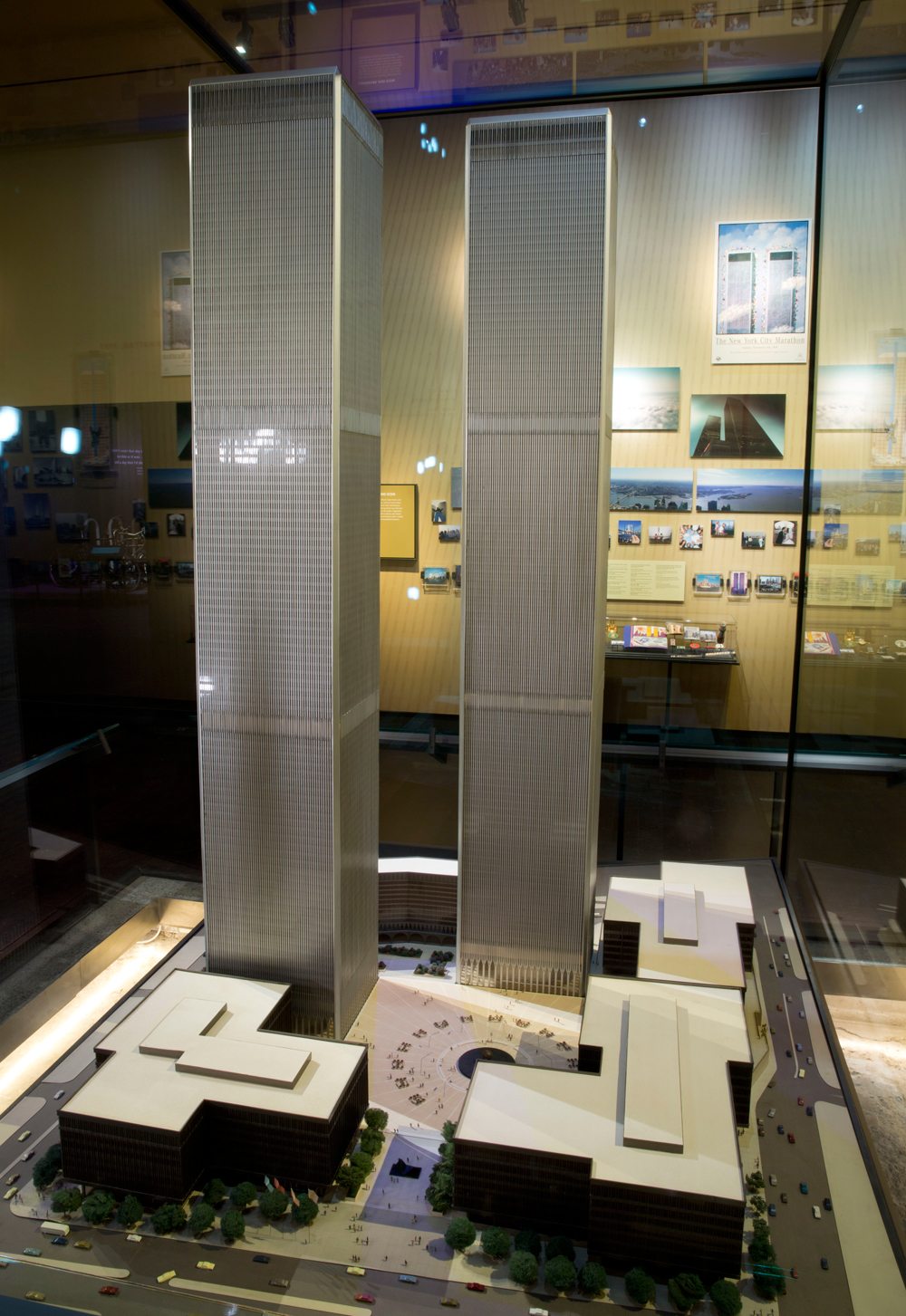
Photo: Jin Lee / Courtesy 9/11 Memorial Museum
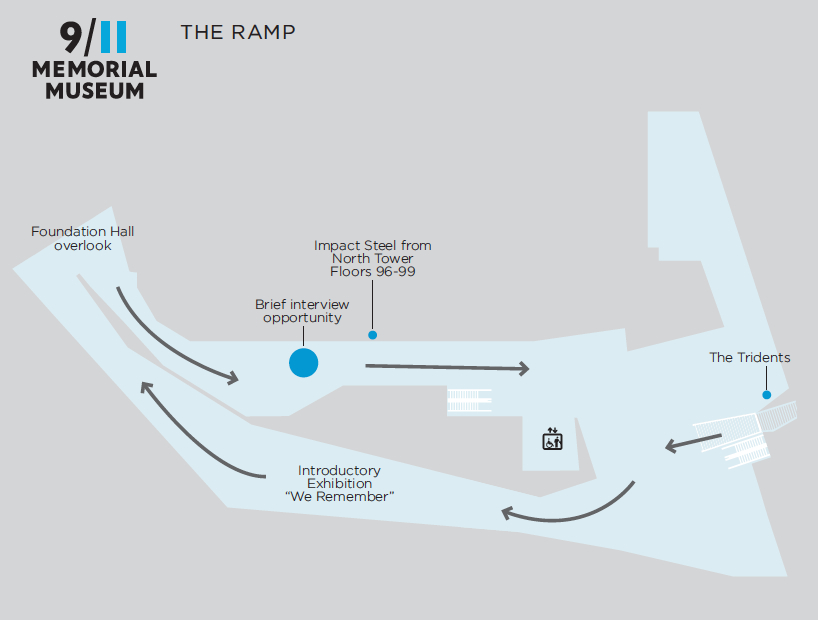
Courtesy 9/11 Memorial Museum
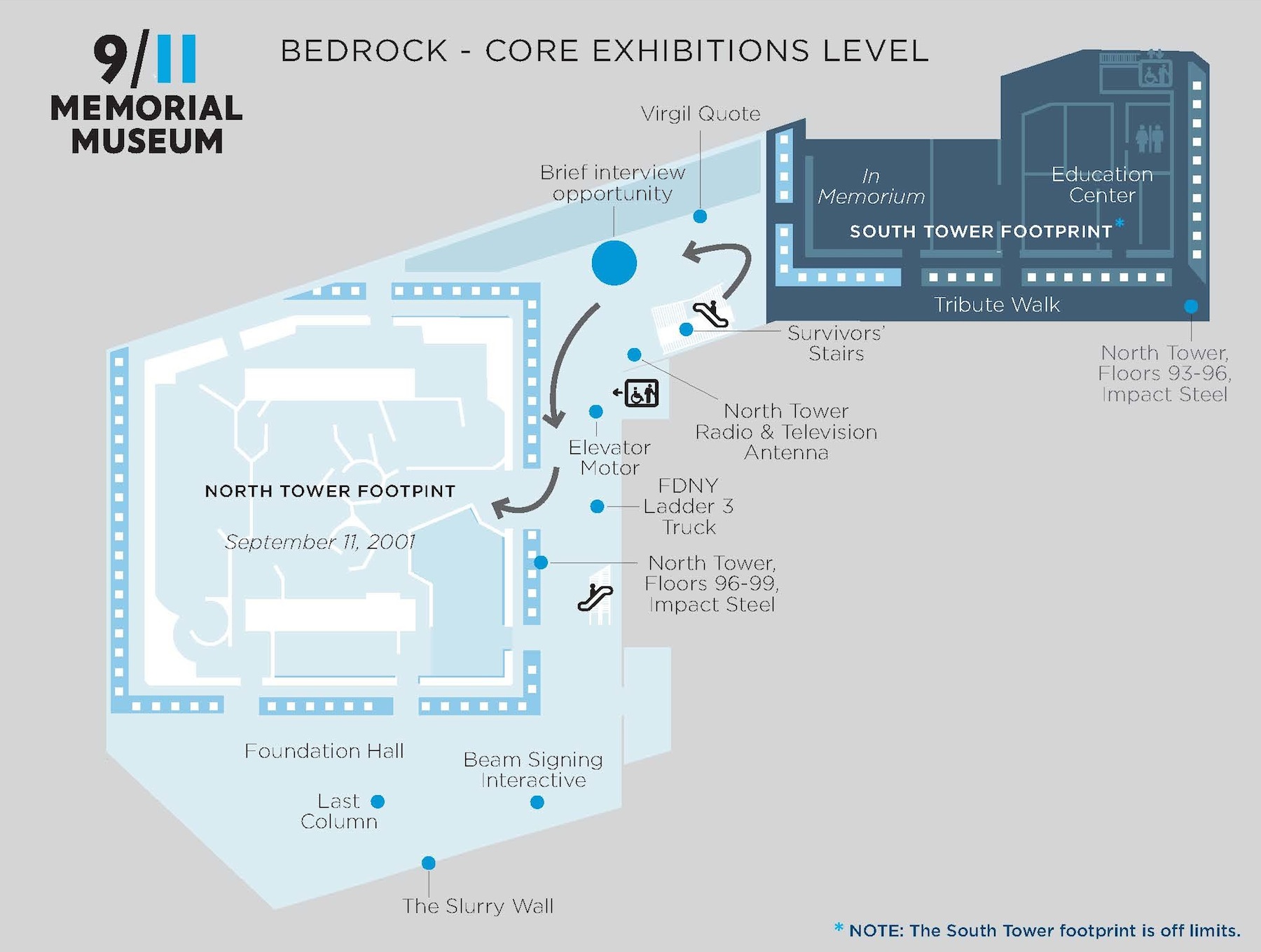
Courtesy 9/11 Memorial Museum
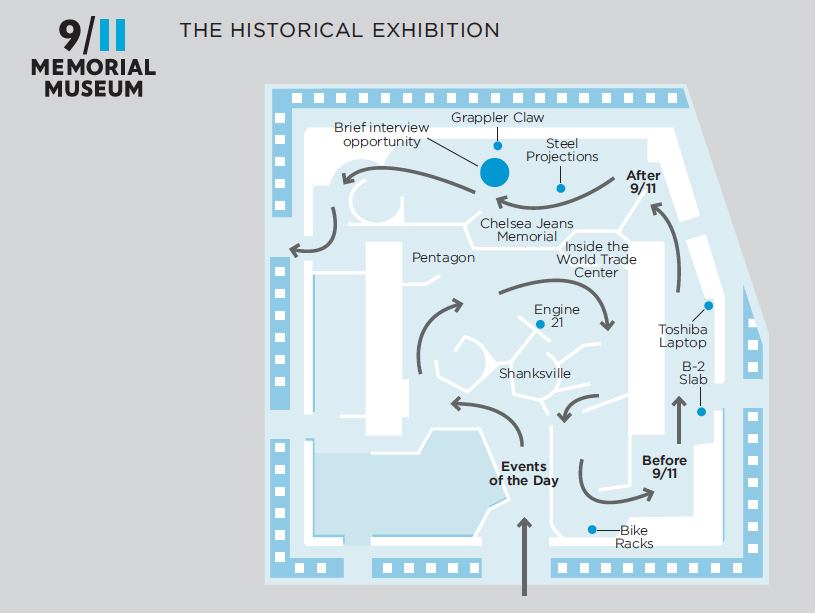
Courtesy 9/11 Memorial Museum
Related Stories
| Dec 13, 2010
Energy efficiency No. 1 priority for commercial office tenants
Green building initiatives are a key influencer when tenants decide to sign a commercial real estate lease, according to a survey by GE Capital Real Estate. The survey, which was conducted over the past year and included more than 2,220 office tenants in the U.S., Canada, France, Germany, Sweden, the UK, Spain, and Japan, shows that energy efficiency remains the No. 1 priority in most countries. Also ranking near the top: waste reduction programs and indoor air.
| Dec 7, 2010
Are green building RFPs more important than contracts?
The Request for Proposal (RFP) process is key to managing a successful LEED project, according to Green Building Law Update. While most people think a contract is the key element to a successful construction project, successfully managing a LEED project requires a clear RFP that addresses many of the problems that can lead to litigation.
| Dec 7, 2010
Blue is the future of green design
Blue design creates places that are not just neutral, but actually add back to the world and is the future of sustainable design and architecture, according to an interview with Paul Eagle, managing director of Perkins+Will, New York; and Janice Barnes, principal at the firm and global discipline leader for planning and strategies.
| Dec 7, 2010
Green building thrives in shaky economy
Green building’s momentum hasn’t been stopped by the economic recession and will keep speeding through the recovery, while at the same time building owners are looking to go green more for economic reasons than environmental ones. Green building has grown 50% in the past two years; total construction starts have shrunk 26% over the same time period, according to “Green Outlook 2011” report. The green-building sector is expected to nearly triple by 2015, representing as much as $145 billion in new construction activity.
| Dec 7, 2010
USGBC: Wood-certification benchmarks fail to pass
The proposed Forest Certification Benchmark to determine when wood-certification groups would have their certification qualify for points in the LEED rating systemdid not pass the USGBC member ballot. As a result, the Certified Wood credit in LEED will remain as it is currently written. To date, only wood certified by the Forest Stewardship Council qualifies for a point in the LEED, while other organizations, such as the Sustainable Forestry Initiative, the Canadian Standards Association, and the American Tree Farm System, are excluded.
| Dec 7, 2010
Prospects for multifamily sector improve greatly
The multifamily sector is showing signs of a real recovery, with nearly 22,000 new apartment units delivered to the market. Net absorption in the third quarter surged by 94,000 units, dropping the national vacancy rate from 7.8% to 7.1%, one of the largest quarterly drops on record, and rents increased for the second quarter in a row.
| Dec 7, 2010
Hot rumor: Norman Foster designing Apple’s new campus
Lord Norman Foster, reportedly has been selected to design Apple’s new campus in Cupertino, Calif. If the news is true, Foster is a good match for Apple say experts. Foster built his celebrity by marrying big gestures to technological wizardry. And, unlike some starchitects, he has glommed onto the environmental revolution—something Apple has made a point of embracing, too.
| Dec 7, 2010
10 megacities of the near future
With Beijing, Shanghai, and Mumbai already on the global radar, where can the next wave of construction be found? Far beyond China, India, and even Brazil it’s predicted. The world’s next future megacities could include Istanbul, Turkey; Ho Chi Minh City, Vietnam; and Khartoum, Sudan, among others. Read about these emerging and little-known behemoths.


